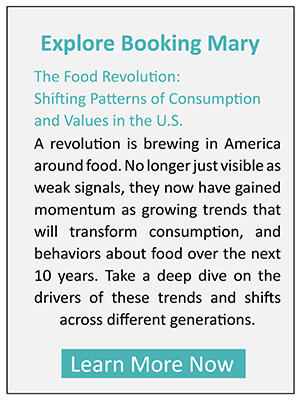You are what you eat.
The old adage is increasingly meaningful as consumers become more knowledgeable not only about health and nutrition, but about food sources and sustainability. The following seven long-term trends will shape the consumption of food for at least the next seven years and have profound implications across diverse industries:
1. Locally Sourced
Consumers increasingly demand to know where their food comes from and strongly prefer local. Greatly influenced by a desire for freshness and superior taste, they also have growing concern regarding food safety, especially from the global supply chain. While “local” is hard to define, the preference is strong nonetheless.
71% of American adults rate locally sourced foods, specifically produce, as the most important factor when thinking about where their food comes from.
2. Natural & Fresh
 “Natural and fresh” is more important to consumers than organic. “Pure” is now a common word used to describe what people are looking for in their food. This growing trend has created several important shifts in preferences, from:
“Natural and fresh” is more important to consumers than organic. “Pure” is now a common word used to describe what people are looking for in their food. This growing trend has created several important shifts in preferences, from:
- Processed foods to whole foods
- Canned & frozen packaging to fresh packaging
- Chemical preservatives to natural preservatives
57% percent of adults report they are more likely to visit a restaurant that serves organic or environmentally friendly food.
3. Relentless Rise of “Snackification”
America has become a country of serial munchers. We are eating more often, especially in the car and on the go, but less at every meal. Many meal foods are now available in a mini size: cheeseburgers give way to sliders, entrees are traded for tapas, and stores and restaurants increasingly cater to snackers. At the same time, snacks are following the fresh and natural trend, becoming healthier with more sophisticated tastes.
Snacks account for 1/5 of all eating occasions.
4. Shift to Fast, Casual, Fun & Great Food
Millennial’s and Gen Xers are hungry for great food prepared by skilled chefs – and they don’t want to wait for it. Younger diners who are looking for something more interesting drive the fast-casual trend. They are looking for something more relaxed than the white tablecloth restaurant their parents are used to. Just having great food is not enough; it must be a fun experience with friends.
While other restaurant industry segments grew by 6.6% or less from 2006 to 2013, “fast-casual” expanded 30%.
5. Desire for Bold Tastes
Taste is king, and tastes are changing fast. Shifting appetites are driven by a quest for bold food flavors and the desire to travel the world through eating and drinking. Millennials, especially, like to put unusual foods and tastes together. Experimenting with fusion foods, specialty drink combinations, and ethnic foods, particularly the more spicy and strong flavors, are part of the adventure they want from a dining experience.
6. Eating for Health
As obesity rates continue to climb, the focus has shifted from healthy eating to eating for health. Americans see the relationship between over-eating and obesity and recognize the steep consequences, including chronic diseases and cost.
In multiple studies, about 2/3 of Americans have stated that they are trying to improve what they eat in order to improve their health.
7. Improved Nutrition for Kids
The rise in nutrition-driven health issues in children has America’s attention. Children themselves are becoming much smarter and vocal about wanting nutritious food. There is a strong move to improve school lunches, but changes have to be tasty for widespread adoption.
40% of children’s food market is healthy
Parting Thoughts
Awareness of the importance of healthy food still outstrips eating behavior, but these growing consumer preferences are shaping disruptive forces on industries from food and beverage to health care to distribution. As we move further into the ‘Economy of Me’ over the next 10 years, it is important to get ahead of these trends’ secondary and tertiary impacts, which will drive a lot of strategy tragedy as we navigate out of the badlands to 2025.
